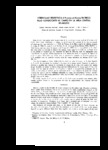Herencia de resistencia a Puccinia striiformis en trigo bajo condiciones de campo en la mesa central de México

View/
Date
1969Author
Hewstone Martínez, Cristian
Acosta Carreón, Aristeo
Roberts, Bill J.
Metadata
Show full item recordAbstract
Para efectuar un estudio sobre la herencia de la resistencia a roya estriada (Puccinia striiformis, West.) bajo condiciones de campo, se utilizó parte del material de la siembra normal del programa de trigo sembrado en el Valle de Toluca, en la Mesa Central de México, durante el verano de 1968. Se recurrió a 25 familias F2 de los progenitores Kalyan 227A, 8156(R) y Siete Cerros, que son líneas hermanas, y de Crespo 63 e INIA 66, a cuyas plantas se les tomaron notas sobre la infección en hojas y en glumas. Tanto para la infección en hojas y en las glumas se encontró que las relaciones de tipos de infección entre los segregantes eran muy difíciles de explicar, debido seguramente a la interacción entre el complejo de razas y el grupo de genes. Igualmente, en ambos casos se encontraron ejemplos de herencia transgresiva y un probable caso de herencia materna entre las cruzas recíprocas de Kalyan 227A X CIANO "S". Para las variedades y líneas involucradas la resistencia para el ataque en la hoja depende de la acción de tres genes. La resistencia al ataque en la gluma parece depender de genes diferentes a aquellos que regulan la resistencia al ataque en la hoja, pero parece que ambos grupos de genes no actúan en forma completamente independiente. La mayor parte de las relaciones entre los tipos de infección en la gluma se ajustan a segregaciones producidas por la acción de tres genes, e indican que la resistencia en la gluma depende de genes de carácter recesivo. De acuerdo con los resultados obtenidos en cruzas con progenitores comunes también se logró identificar diferencias genotípicas entre las variedades, tanto para la resistencia en las glumas como en las hojas. El método seguido en el presente estudio puede servir como un medio para obtener información genética dentro de los programas normales de mejoramiento, sin esfuerzo adicional considerable. ABSTRACT: This is a study on the heredity of wheat resistance to the yellow rust (Puccinia striiformis, West) under field conditions. Part of the material of the wheat experimental programa at the Toluca Vallery in Summer 1968 was used to carry out this study. Twenty five families F2 from the sib lines Kalyan 227A, 8156R and Siete Cerros were used. The lines Crespo 63 and INIA 66 were used also. Notes of the infection on leaves and glumes of the plants were taken. It was found that the relations of the types of infection on glumes and leaves of segregating plants were difficult to explain, due to the interaction of the races complex and the group of genes. In both cases, examples of transgresive inheritance were found, and a probable case of material inheritance among the reciprocal crosses Kalyan 227A X CIANO "S" was found. The resistance of varieties and lines, to the attak of the rust on leaves depends on the action of three genes. It seems that the resistance to the attack of the rust to the glumes depends on genes different from those that regulate the resistance to the attack of the rust to the leaves, also, it seems that both groups of genes are not completely independent from each other. Most of the relations among the types of infection on the glume are adjusted to segregations produced by three genes and indicate that the resistance of the glumes to the attack of rust depends on recessive genes. Based on the established relations of mutual progenitors crosses, it was posible to identify genotypical differences among plants of some varieties for the resistance of the glumes as well as the leaves. The method followed in this study might serve as a means to obtain genetical information using the conventional breeding programs with Little additional work.
Collections
- Agrociencia [55]
